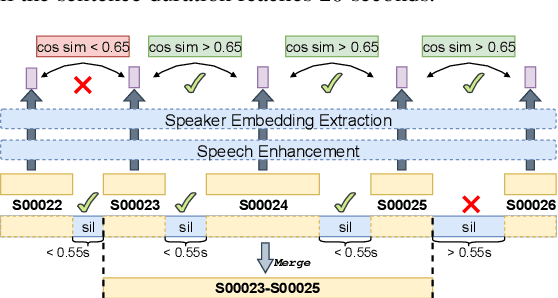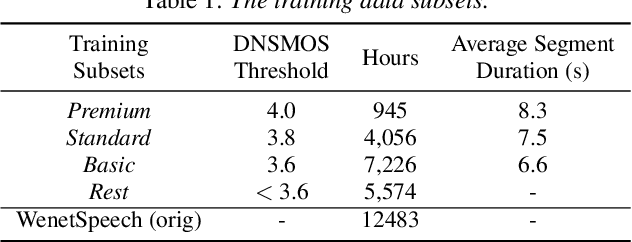Linhan Ma
Vec-Tok-VC+: Residual-enhanced Robust Zero-shot Voice Conversion with Progressive Constraints in a Dual-mode Training Strategy
Jun 14, 2024Abstract:Zero-shot voice conversion (VC) aims to transform source speech into arbitrary unseen target voice while keeping the linguistic content unchanged. Recent VC methods have made significant progress, but semantic losses in the decoupling process as well as training-inference mismatch still hinder conversion performance. In this paper, we propose Vec-Tok-VC+, a novel prompt-based zero-shot VC model improved from Vec-Tok Codec, achieving voice conversion given only a 3s target speaker prompt. We design a residual-enhanced K-Means decoupler to enhance the semantic content extraction with a two-layer clustering process. Besides, we employ teacher-guided refinement to simulate the conversion process to eliminate the training-inference mismatch, forming a dual-mode training strategy. Furthermore, we design a multi-codebook progressive loss function to constrain the layer-wise output of the model from coarse to fine to improve speaker similarity and content accuracy. Objective and subjective evaluations demonstrate that Vec-Tok-VC+ outperforms the strong baselines in naturalness, intelligibility, and speaker similarity.
WenetSpeech4TTS: A 12,800-hour Mandarin TTS Corpus for Large Speech Generation Model Benchmark
Jun 11, 2024



Abstract:With the development of large text-to-speech (TTS) models and scale-up of the training data, state-of-the-art TTS systems have achieved impressive performance. In this paper, we present WenetSpeech4TTS, a multi-domain Mandarin corpus derived from the open-sourced WenetSpeech dataset. Tailored for the text-to-speech tasks, we refined WenetSpeech by adjusting segment boundaries, enhancing the audio quality, and eliminating speaker mixing within each segment. Following a more accurate transcription process and quality-based data filtering process, the obtained WenetSpeech4TTS corpus contains $12,800$ hours of paired audio-text data. Furthermore, we have created subsets of varying sizes, categorized by segment quality scores to allow for TTS model training and fine-tuning. VALL-E and NaturalSpeech 2 systems are trained and fine-tuned on these subsets to validate the usability of WenetSpeech4TTS, establishing baselines on benchmark for fair comparison of TTS systems. The corpus and corresponding benchmarks are publicly available on huggingface.
Accent-VITS:accent transfer for end-to-end TTS
Dec 29, 2023


Abstract:Accent transfer aims to transfer an accent from a source speaker to synthetic speech in the target speaker's voice. The main challenge is how to effectively disentangle speaker timbre and accent which are entangled in speech. This paper presents a VITS-based end-to-end accent transfer model named Accent-VITS.Based on the main structure of VITS, Accent-VITS makes substantial improvements to enable effective and stable accent transfer.We leverage a hierarchical CVAE structure to model accent pronunciation information and acoustic features, respectively, using bottleneck features and mel spectrums as constraints.Moreover, the text-to-wave mapping in VITS is decomposed into text-to-accent and accent-to-wave mappings in Accent-VITS. In this way, the disentanglement of accent and speaker timbre becomes be more stable and effective.Experiments on multi-accent and Mandarin datasets show that Accent-VITS achieves higher speaker similarity, accent similarity and speech naturalness as compared with a strong baseline.
 Add to Chrome
Add to Chrome Add to Firefox
Add to Firefox Add to Edge
Add to Edge